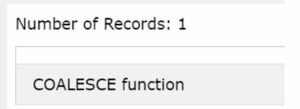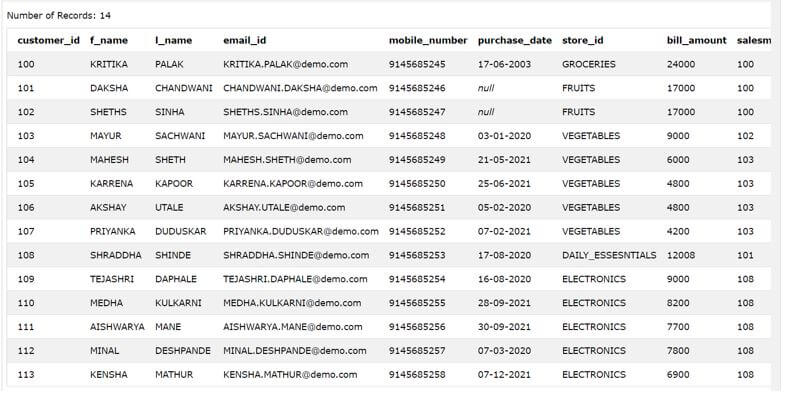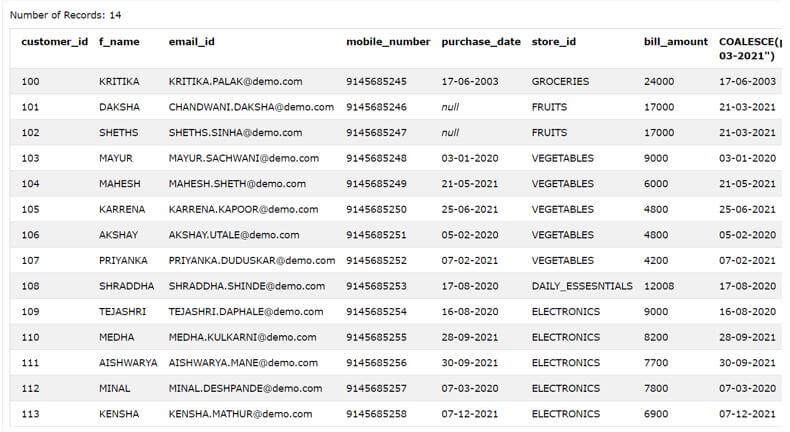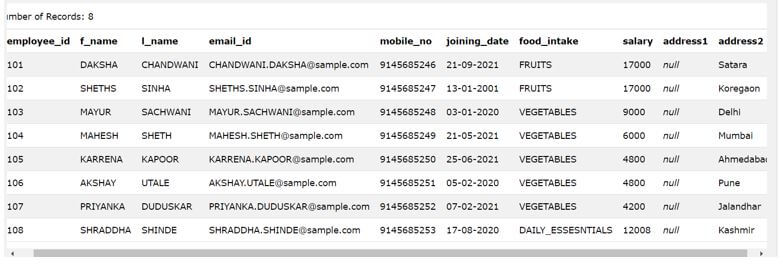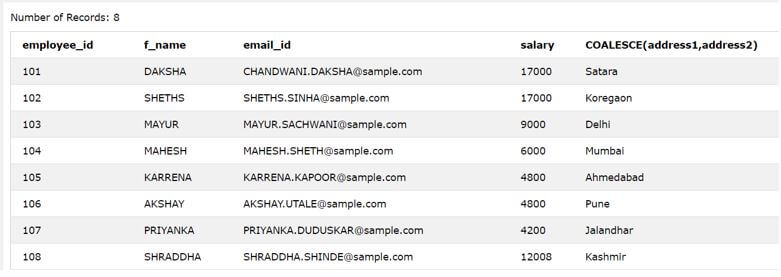Updated March 6, 2023

Introduction to DB2 COALESCE
DB2 COALESCE is used to handle the NULL values that might be present in the data or list of values that are specified. When the data is stored in DB2 RDBMS, we use the tables and store the data in rows and columns format. If the NOT NULL constraint on the column is not applied, then the default value that gets inserted in those columns when not specified is the NULL value. While retrieving and displaying the data to the user, it is not good to display certain columns’ NULL valueshat case, we can use the COALESCE function in DB2, which will help us get the first non NULL value from the list of the parameters specified while using it.
Syntax:
The syntax of the COALESCE function in DB2 is as shown below:
COALESCE(expr1,expr2,expr3,…,exprn)
In the above syntax, the specification of atleast a single value is compulsory. However, we can specify the other values optionally. The expr are the expressions that can be any constant value of even the column’s name whose value you wish to retrieve. The coalesce function searches for the non-null value in all the specified parameters expressions. Whichever expression evaluates to non-null value first, that value is considered the resultant and returned as an output. However, note that if all the coalesce function’s expressions evaluate to null, it returns the NULL value.
Examples of DB2 COALESCE
Given below are the example of DB2 COALESCE:
Use of COALESCE function to retrieve the first non-NULL value from the list of the values that are specified as the fixed values.
Let us first consider the use of COALESCE function with the list of values (NULL, NULL, NULL, ‘COALESCE function’, NULL, ‘EDUCBA’)
Code:
SELECT COALESCE (NULL, NULL, NULL, 'COALESCE function', NULL, 'EDUCBA');
The execution of the above query statement gives the following output as the resultant and gives out the first non-null value from the list of specified values in the coalesce parameters.
Output:
Now, consider that we remove the COALESCE function string from the list and place the NULL value in its place. So, the first non-null value from the list will be EDUCBA. Hence, the execution of the following query statement gives out EDUCBA as the output.
Code:
SELECT COALESCE(NULL, NULL, NULL, NULL, NULL, 'EDUCBA');
The output of the execution of the above query statement is as shown in the below image.
Output:
Passing NULL values in the list.
If we supply all the parameters as NULL, then it gives out the error. The COALESCE function goes for searching the first non- NULL value and fails in finding the same. Hence it throws an error saying that it should contain atleast one argument, which is having the non-NULL value.
Code:
SELECT COALESCE(NULL, NULL, NULL, NULL, NULL, NULL);
Execution of the above statement gives the following error shown in the image.
Output:
Use of COALESCE function for substituting the NULL values stored in columns of the table.
The main purpose of the COALESCE function is to display any non- NULL value in place of NULL values when a particular column of the table is given the NULL constraint or not provided the NOT NULL constraint. In case if default value is not specified for that column or the column is kept to AUTOINCREMENT value, then by default, the value that gets inserted for that column is the NULL value. Suppose that we have one table named Sales_Customers.
If we retrieve the data of the table sales_customers from the database right now by using the following query statement.
Code:
SELECT * FROM [Sales_Customers];
Execution of the above statement gives the following result with all the values of the column purchase_date having the value NULL for store_id column having the value of FRUITS in it as shown below.
Output:
If we have to replace the value of NULL in the purchase_date column, then we can do that by using the COALESCE function by giving the first argument as the name of the column of purchase_date, and then the second argument can be any non-NULL value with which we want to replace the NULL value with. The COALESCE function will search the first non-NULL value; if the column has any date stored in it, it displays that date; else, it goes further to replace that null value stored in the column with the value specified in the second parameter. Suppose that we have to show the default date as “21-03-2021”. Then we can use the COALESCE function while retrieving the table’s values by using the following SELECT query statement.
Code:
SELECT customer_id, f_name , email_id , mobile_number , purchase_date , store_id , bill_amount , COALESCE(purchase_date,"21-03-2021") FROM [Sales_Customers];
The above query statement’s outputhown below with replacing the values of the purchase date column with null values with the date that we have specified in the last value retrieved in the select query.
Output:
We can also make the use of the COALESCE function to replace the column value having NULL in it with some other column value by specifying the column containing NULL values as the first argument and the column with which the value needs to be replaced in the second argument.
Consider an example where we have the table named workers created by using the following query statement.
Code:
CREATE TABLE workers(
employee_id INT NOT NULL ,
f_name VARCHAR(50) NULL,
l_name VARCHAR(50) NULL,
email_id VARCHAR(50) NULL,
mobile_no INT NULL,
joining_date VARCHAR(50) NULL,
food_intake BOOLEAN NULL,
salary FLOAT(10, 2) NULL,
address1 VARCHAR(50) NULL,
address2 VARCHAR(50) NULL,
PRIMARY KEY (employee_id )
)
The data of the table is as shown below:
Code:
SELECT * FROM [workers]
Output:
Using the following query statement, we can display the column address2 value in address1 place if it is NULL, as shown below.
Code:
SELECT employee_id,f_name, email_id, salary, COALESCE(address1,address2) FROM [workers]
Output:
Conclusion
We can use COALESCE function to handle the NULL values present in the table columns or present in the list for replacement or substitution with some other value.
Recommended Articles
This is a guide to DB2 COALESCE. Here we discuss the introduction and examples of DB2 COALESCE for a better understanding. You may also have a look at the following articles to learn more –

